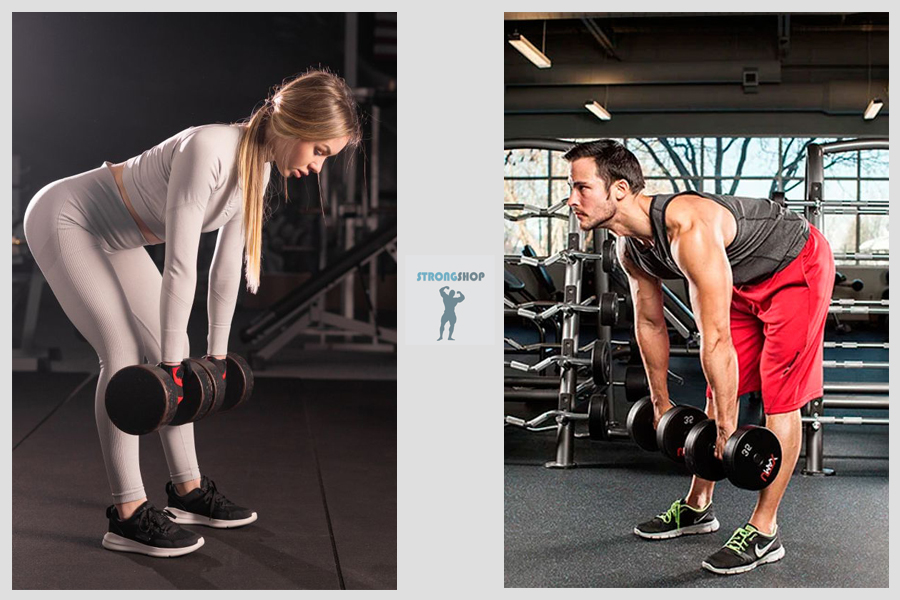The deadlift is one of the most effective exercises for strengthening the back and leg muscles. Let's take a closer look at its dumbbell version.
While the classic version is usually done with a barbell, using dumbbells is a great alternative, perfect for bodybuilding beginners.
We’ll explore the main types of dumbbell deadlifts, execution techniques, and the benefits of this exercise.
General Characteristics
- Exercise type: Basic
- Equipment: Dumbbells
- Difficulty level: Medium
- Major muscle groups: Legs and back
Application and Benefits
- Versatility. Dumbbells make it easier to understand the proper technique.
- Minimal space needed, which is especially useful for those training at home.
- Reduced spinal load. Unlike the classic barbell deadlift, the dumbbell deadlift places less pressure on the spine, making it safer for those with lower back issues.
- Improved balance. Each movement with dumbbells requires more focus and core stability, enhancing balance and coordination.
- For weight-loss-focused training: The exercise promotes calorie burning and boosts metabolism, aiding in weight loss.
- For men, especially beginners, the dumbbell deadlift is effective for building mass and strength, targeting the back, legs, and glutes.
- For women: This exercise is ideal for those aiming to enhance glute and hamstring shape. Glute-focused variations, like the Romanian deadlift, are particularly popular among women.
People with injuries who are temporarily unable to work with barbells and heavy weights can also perform this exercise.
Dumbbell Deadlift Technique
- Back position: Keep the back straight throughout, with a slight arch in the lower back. Avoid rounding the back to prevent injury.
- Foot placement: Feet should be shoulder-width apart, with toes slightly turned outward.
- Weight control: The movement should be slow and controlled. Avoid dropping the weight, as this reduces muscle tension.
- Proper breathing: Inhale while lowering the dumbbells, exhale while lifting them.
Common Mistakes
- Rounding the back: This is a common mistake that increases the risk of spine injury. Always keep the back straight.
- Lifting with the back: The rules are the same as with the barbell. Start the lift with the legs; the back engages later.
Main Types of Dumbbell Deadlifts
Classic version
This is the basic exercise, primarily targeting the leg, glute, and back muscles. It’s performed while standing with feet shoulder-width apart, holding dumbbells along the body.
Execution technique:
Stand upright, holding dumbbells in front of your thighs.
Slowly lower yourself by bending your knees and pushing your hips back, keeping your back straight.
Lower the dumbbells to mid-shin, then return to the starting position by engaging the glutes and back muscles.
Romanian Dumbbell Deadlift
In this version, emphasis is placed on the hamstrings and glutes. Legs remain nearly straight, with minimal knee bending. The primary movement driver is the hips.
Execution technique:
Stand upright with feet shoulder-width apart, holding dumbbells in front of your thighs.
Slightly bend your knees and lean forward, pushing your hips back, allowing the dumbbells to move along your legs.
Once you reach just below knee level, return to the starting position, contracting your glutes and straightening your torso.
Alternatives
If, for any reason, you cannot perform the dumbbell deadlift, other exercises can target the same muscle groups:
- Romanian barbell deadlift. A great alternative for those who prefer working with heavier weights.
- Classic barbell deadlift. This variation is better suited for those aiming to work with maximum weights and build overall strength.
How to Choose Dumbbells for the Deadlift
When selecting dumbbells for the deadlift, consider your fitness level:
- For beginners: Start with light weights (5-10 kg) to master the technique and avoid injuries.
- For experienced lifters: Gradually increase the weight, paying attention to your form. Control is key.
Home Dumbbell Deadlift
One of the main advantages of the dumbbell deadlift is that it can easily be done at home.
All you need is a pair of dumbbells and some free space. To create an effective home workout routine, you can add other exercises like dumbbell squats, lunges, and chest presses to the deadlift.
Conclusion
The dumbbell deadlift is a versatile and effective exercise for building strength and endurance, suitable for both beginners and advanced athletes. Adding this exercise to your routine will help improve glute shape, strengthen your back and legs, and allow you to reach your fitness goals faster and more safely.
Remember to focus on proper technique and gradually increase the load to maximize the benefits of the dumbbell deadlift.
Dumbbell Deadlift FAQ
What weight is best for beginners?
Beginners should start with dumbbells weighing 5-10 kg, gradually increasing the load.
Can the classic dumbbell deadlift be substituted with other exercises?
Yes, the Romanian version can be an alternative for variety. And, of course, if you want more intensity, the barbell option is available.
How many repetitions should I do?
It’s recommended to perform 8-12 repetitions in 3-4 sets, depending on your fitness level and workout goals.
How can I avoid injuries?
Maintain proper form, avoid rounding your back, and choose an appropriate weight. Overall, this exercise is not particularly difficult.



